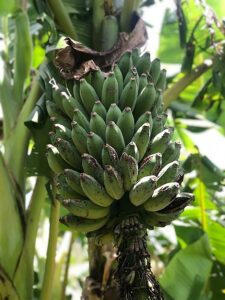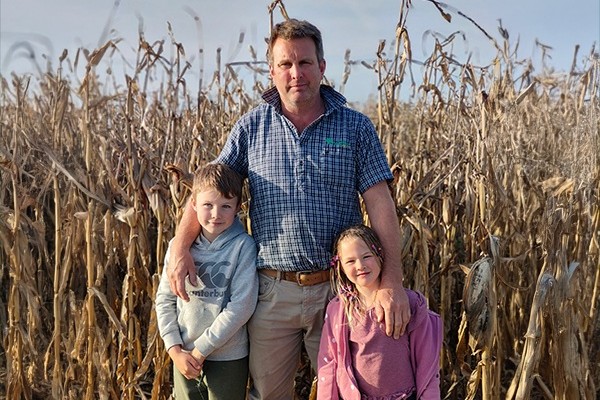As the north warms, one dairy farmer is looking for expertise to turn bananas into a future forage crop and a more sustainable effluent cycling system. Delwyn Dickie reports.
Northland and northern Waikato are getting warmer and drier. Farmers need sustainable changes to farm systems, so they are fit for the future, says dairy farmer Graeme Edwards.
Back in 2018 after a suggestion from their son Paul, a farm systems scientist with DairyNZ, Graeme and Carol Edwards planted up a plot of banana plants adjacent to their dairy effluent pond. They ran trickle irrigation lines through the rows of 65 stems so they could be fed with effluent from the pond.

Graeme was hopeful the plot of Misi Luki bananas could be used to evaluate the possibility of growing bananas as a new summer-autumn forage crop for northern dairy farms and potentially become a more sustainable option for the recycling of dairy effluent.
His efforts to kickstart the conversation around bananas in a dairy system left him frustrated. While there was strong interest from media, there was little practical research help or guidance from industry or otherwise. Funding was eventually sourced from the Our Land and Water Rural Professionals Fund, and Dr Warren King and Grant Rennie from AgResearch were able to get some research underway.
Now well into his 60s and running three farms, Graeme feels bananas have the potential to provide significant benefit to farming in the north. He is hopeful the results of the study, showing the project has merit, will act as a catalyst for action.
Maximising drymatter
When Warren and Grant had a look at the mini-plantation, the banana plants were nearly two years old and towered over Graeme and Carol. Some were sending up the first stems that would flower and produce fruit.
Although there is potential for the plants to produce saleable fruit, the focus of this research was on measuring growth, uptake of nutrients from effluent, and the nutritional content of banana stems as forage for cattle.
Cutting off the main stem of a young plant to make the plant bulk out is an old gardening technique, used in this research to push smaller and outlying stems to grow faster and encourage more new stems to grow. It was meant to approximate what might be left behind after a previous season’s harvest or grazing.
The bananas proved to be more than up to the challenge of some serious hacking. In September 2020, 15 palms had their main stem cut out, some with a forming spike that would have eventually become a flowerhead, along with some other stems of varying heights before being left to regrow.
Compared to 15 other plants that had been left uncut, by January there wasn’t a lot of difference in the final number of stems. All had grown more stems. The cut bananas hadn’t produced greater numbers, although they did grow faster and had regrown to their original height.
The fastest growth came from stems cut out that hadn’t yet started to produce what would eventually be a flower spike, and these shot up to over two metres high by January.
Two plants were also cut down completely on Graeme’s suggestion in January, as if they had been fully grazed. By the end of June these had also grown back to 1.5m.
Estimates of drymatter (DM) from the stems and foliage were taken for cut and uncut plants in September, December, January and June. This saw the uncut plants go from an estimated 6.8kg DM/plant in September 2020 to an estimated 15.9kg DM/plant by June 2021.
A typical banana plantation such as those grown for fruit rather than foliage in Queensland, Australia, has 1600 plants per hectare. For Graeme and Carol’s plantation this equates to 14.6 tonnes DM/ha. At 2000 plants per hectare, also common for some varieties, this could be substantially higher, especially as their palms are still quite young.
The cut plants bulked out from 3.2kg DM/plant to 14.6kg DM/plant in the same time frame, giving an impressive 18.4T DM/ha with the strongest regrowth from the middle stem. The biggest growth spurt happened between December and January when the cut plants increased their DM by 75%, leaving the uncut palms behind with around 40% increase.
Regrowth is impressive, especially as it came in the heat of summer when soil was dry and pasture might be starting to struggle. But how much of a toll the rapid regrowth has on the plant’s future health and longevity, if it is subject to this onslaught every summer remains to be seen.
A summer treat
Graeme had heard of banana plants being fed to cattle in Queensland. Although not part of this research, he had been throwing the cut plant scraps over the fence to his cows. Initially they seemed a bit uncertain but were soon happily devouring, leaf, smaller stems, and fruit.
While they may have been tasty, did the plants have any food value as a forage? Overall, the bananas showed potential as a suitable feed crop for cows, with digestibility similar to various silages.
Using near-infrared spectroscopy (NIR) on the cuttings along with some ‘wet’ testing showed crude protein was low – like summer pasture in the leaves, with the stalk even lower – like maize silage.
Neutral detergent fibre content was low in the leaves, like spring pasture, with the stem also low, like turnip bulbs (low fibre is good for dairy cows).
With a couple of boxes ticked as a forage, then came testing the nutrient uptake from effluent.
Graeme ran dairy effluent to the banana plot regularly over summer, although volume applied was not measured. In June, soil samples were taken at four depths to see how minerals were moving through the soil profile. This showed no unexpectedly high levels of nitrogen or potassium.
Next steps
Warren and Grant see the banana forage and effluent uptake concept as having merit and being worthy of more research.
There also appear to be some valuable opportunities. While there is some literature on feeding banana fruit to animals, there are very few places in the world where banana stem and leaf is fed to livestock and very little published work.
“The only work we could find was a tiny little study in the Canary Islands where someone was feeding banana stems to goats. So this is not a common thing to feed stem and leaf to ruminants let alone dairy cows,” Warren says.
The next step would be to do more research with animals and a closer look at the nutrient uptake and cycling.
While Graeme was happy to feed his cows with the plant offcuts and scraps, and the animals seeming to enjoy them, Warren emphasises that this was not part of the trial.
Warren says this trial has been useful to check for “red flags” before testing on animals, which requires significant research funding. “We discovered none.”





